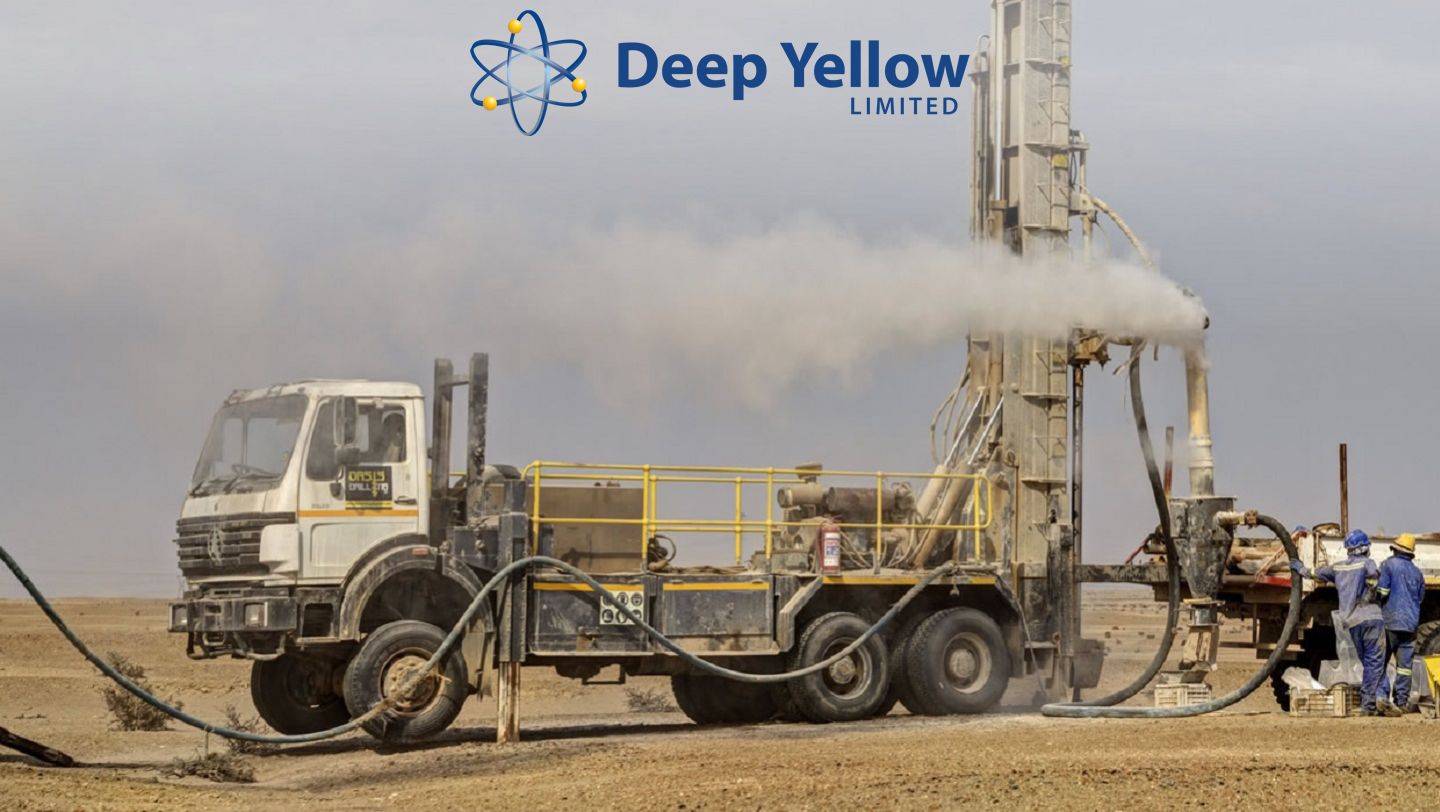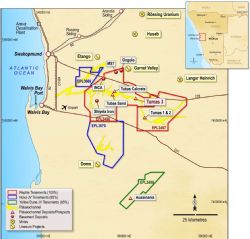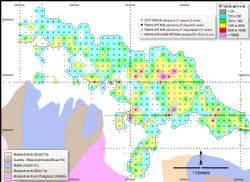
Maiden Tumas 3 Resource Confirms High Project Potential
Perth, Oct 10, 2017 AEST (ABN Newswire) - Deep Yellow Limited ( ASX:DYL) (
ASX:DYL) ( DYLLF:OTCMKTS) (Deep Yellow) is pleased to announce its highly encouraging maiden mineral resource estimate (MRE) for the Tumas 3 discovery which, at a 200ppm eU3O8 cut-off, comprises 23.5Mlb inferred mineral resources at a grade of 382ppm eU3O8. This deposit occurs on EPL3496, held by the Deep Yellow wholly-owned subsidiary Reptile Uranium Namibia (Pty) Ltd (RUN). The MRE was undertaken using various cut-off grades using a minimum thickness of 1m and conforms to the 2012 JORC Code of Mineral Resource Reporting.
DYLLF:OTCMKTS) (Deep Yellow) is pleased to announce its highly encouraging maiden mineral resource estimate (MRE) for the Tumas 3 discovery which, at a 200ppm eU3O8 cut-off, comprises 23.5Mlb inferred mineral resources at a grade of 382ppm eU3O8. This deposit occurs on EPL3496, held by the Deep Yellow wholly-owned subsidiary Reptile Uranium Namibia (Pty) Ltd (RUN). The MRE was undertaken using various cut-off grades using a minimum thickness of 1m and conforms to the 2012 JORC Code of Mineral Resource Reporting.
HIGHLIGHTS
- Tumas 3 discovery returns an impressive maiden mineral resource estimate of 23.5Mlb at a grade of 382ppm eU3O8 as inferred resources located on its 100% owned project.
o Achieved 5.34Mlb/km of uranium mineralisation, exceeding the original 3 - 5Mlb/km expectation.
- Maiden resource contributes a significant 47% improvement to the existing palaeochannel related mineral resource.
o This significantly advances the project toward achieving stated objectives.
- Tumas 3 remains open and results fully support the high prospectivity of the 100km of palaeochannel target that has been delineated and remains to be tested.
- New 7,500m drill program funded by JOGMEC now underway at the Nova JV.
- Drilling to resume on DYL's 100% owned EPLs in December quarter 2017.
A three month drilling program at Tumas 3 was completed in July 2017. Drilling outlined a 4.4km long zone of continuous calcrete uranium mineralisation. Of the total 400 holes drilled (for 10,545m), 284 returned positive results - an overall 71% success rate. Mineralisation remains open both west and east and will be the subject of further drilling. Figure 1 (see link below) shows the location of Tumas 3.
The Tumas 3 discovery has significantly increased the Company's surficial calcrete palaeochannel mineral resource base on this project by 47% which now totals 73.6Mlb U3O8.
The mineralisation at Tumas 3 occurs as a distinct mineralised body separate from the other uranium mineral resources the Company has previously identified elsewhere within these palaeochannels in its Tumas 1 & 2 and Tubas Red Sands/Calcrete deposits (see Figure 1 in the link below).
The palaeochannels at Tumas 3, which occur separate from these deposits, have only been sparsely drilled along widely spaced regional lines with large sections completely untested.
Exploration Target
Deep Yellow has identified 100km of palaeochannel targets with large sections remaining to be tested. The very encouraging results at Tumas 3 from drilling over 4.4km gives the management team confidence that the Company has notably advanced towards reaching its stated total Exploration Target (see Note below) of 100 - 150Mlb at a grade range of 300ppm - 500ppm for this type of uranium mineralisation. Deep Yellow's total JORC conforming uranium resources on its Namibian projects are shown in Appendix 1 (see link below).
Tumas 3 Mineral Resource Estimate Summary
Cut-off grades used for the MRE included 100, 150, 200, 250, and 300ppm eU3O8 and the inferred resources derived from these cut-off grades indicate the mineralisation is robust and consistent (see Table 1 in the link below).
The MRE for the Tumas 3 deposit at a 200ppm cut off gives an inferred resource of 23.5Mlb at 382ppm eU3O8 as shown in in Table 1 (see link below). The 200ppm eU3O8 cut-off has been selected as being the most appropriate for headline reporting of the resource estimations.
Deposit Parameters: The Tumas 3 uranium mineralisation is of the calcrete type located within an extensive generally east west trending palaeochannel system. The uranium mineralisation occurs in conjunction with calcium carbonate precipitations (calcrete) in sediment filled palaeovalleys. Uranium is the only economically extractable metal in this type of mineralisation although vanadium production can be considered if the price for vanadium is high enough. Uranium minerals mainly include uranium vanadates. The geology of this type of mineralisation is well understood having been explored over a number of years. The Langer Heinrich uranium mine, located 30km to the north-east, exploits this type of deposit and has been mined since 2007.
The mineralisation domains used for the current MRE study were interpreted to capture continuous zones of mineralisation above 100ppm eU3O8. The mineralisation included in this study has a strike length of approximately 4.4km with a width of around 300m to 900m and extends to a maximum depth of 25m. The mineralisation occurs in a reasonably continuous, seam-like horizon and extends east and west beyond the currently drilled area.
Drilling for the project was based on RC methods only. Drill holes used in the mineral resource estimation included the 400 recently drilled holes totalling 10,545m and 338 historical drill holes totalling 8,343m drilled by Deep Yellow between 2011 and 2012. Drilling achieved recoveries around 90%. All drill chips were logged geologically and their radioactivity was measured. All data were added to the database.
The recent drilling was carried out on a spacing of 100m x 100m. Previous drilling carried out by the Company was along regional 2km spaced drill lines with drill holes spaced 50m apart which was of insufficient resolution to make a discovery.
Methodology: Data used in the mineral resource estimate is largely based on down-hole radiometric gamma logging taken by a fully calibrated Aus Log gamma logging system which was used in the recent and previous drilling programs. Down-hole gamma readings were taken at 5cm intervals and converted into equivalent uranium values (eU3O8) before being combined to 1m intervals. Geochemical assays were collected from 1m RC-drilling intervals, which were split into 1 to 1.5kg samples by riffle splitters. A further 120 grams were pulverised for use in XRF analysis. Selected samples from the historical holes previously drilled were also assayed for U3O8 by ICP-MS method to confirm the XRF results. For further description of sampling techniques and associated data see Appendix 2, Table 1 (see link below).
The mineral resource was estimated by Ordinary Kriging.
The geochemical assays were used to confirm the validity of the eU3O8 values determined by down-hole gamma probing. After validation, the eU3O8 values derived from the down-hole gamma logging were given preference over geochemical assays for the resource estimation.
The relevant drill hole details and results were previously reported by Deep Yellow in announcements made to the ASX on 11 July, 22 June, 22 May and 19 April 2017.
Figure 2 (see link below) shows a grade thickness (GT- eU3O8ppm x metre thickness) contour map of the Tumas 3 deposit, showing extent and nature of the mineralisation over the full 4.4km length drilled. A cross-section and a long-section is shown through the Tumas 3 uranium mineralisation in Figures 3 and 4 (see link below) respectively.
High Potential and Future Drilling
This first phase of drilling at Tumas 3, with the adoption of a fresh exploration focus under the stewardship of the new management of Deep Yellow, has proved highly effective and fully endorses the approach that is being taken. The work has identified substantial new uranium resources at Tumas 3 where previously none was thought to have existed. Additionally, work during the past 10 months has also identified extensive untested palaeochannels for which high prospectivity is now being confirmed.
The Tumas 3 deposit currently defined over a strike length of 4.4km demonstrates that these fertile palaeochannels can hold 5Mlb/km of uranium where mineralised. With Tumas 3 remaining open to the immediate east and west and a further 100km of palaeochannel identified still to be tested, it is not unreasonable to estimate that 15 - 20km of these channel systems will return 3 - 5Mlb/km of uranium mineralisation.
The Tumas 3 deposit has no surface expression and therefore could only be discovered through drilling. This leaves abundant opportunity to extend the currently defined resources at Tumas 3 and for making further discoveries within the insufficiently tested, highly prospective palaeochannel system of 100km in length. It strongly justifies the need to continue exploration and systemically drill test the underexplored palaeochannel systems contained in the Company's 100% owned tenements, EPLs 3496 and 3497.
Drilling will be resumed on these targets late in the December quarter 2017.
Current Drilling on adjoining Nova JV Project
A 7,500m reverse circulation/diamond drilling program is currently being carried out by Deep Yellow on the adjoining Nova JV project where JOGMEC is earning a 39.5% interest on expenditure of $4.5M over four years. This drilling program is focussing on first pass testing of targets identified from extensive mapping and geophysical surveys carried out over selected parts of EPLs 3669 and 3670 during the November 2016 - August 2017 period. The exploration targets are for both alaskite associated basement targets (Rossing and Husab type) and surficial palaeochannel associated calcrete targets (Langer Heinrich type). The main bulk of this drilling is to test the nature of some of the bedrock anomalies identified by the ground IP, radiometrics and airborne EM and to establish existence of uranium fertile palaeochannels.
This program is scheduled to be completed by end November 2017.
Note: The Company has already determined an MRE of 73.6Mlb of calcrete mineralisation (or 70% of the lower range of the Exploration Target, however, it acknowledges that the potential quantity and grade of the exploration target is conceptual in nature, and that there has been insufficient additional exploration to estimate an expanded Mineral Resource at the date of this report. Additional exploration is planned, however it is uncertain if this will result in the estimation of an expanded Mineral Resource. From the review and evaluation of calcrete associated mineralisation already identified on the Company's tenements which commenced in the December Quarter and the exploration carried out over recent months, the Company has a greater understanding of the stratigraphy of the palaeochannels which host mineralisation. This work has provided renewed confidence that mineralisation is likely to be identified in targeted but contiguous areas on our tenements.
Targeted tonnage/grades are based on results and understanding from work carried out over past 10 years in this region. The Exploration Targets are planned to be tested over the next 12 to 24 months by an exploration program including geophysical field work and drill testing of targeted areas.
To view tables and figures, please visit:
http://abnnewswire.net/lnk/S4C6G65T
About Deep Yellow Limited
 Deep Yellow Limited (ASX:DYL) (OTCMKTS:DYLLF) is successfully progressing a dual-pillar growth strategy to establish a globally diversified, Tier-1 uranium company to produce 10+Mlb p.a.
Deep Yellow Limited (ASX:DYL) (OTCMKTS:DYLLF) is successfully progressing a dual-pillar growth strategy to establish a globally diversified, Tier-1 uranium company to produce 10+Mlb p.a.
The Company's portfolio contains the largest uranium resource base of any ASX-listed company and its projects provide geographic and development diversity. Deep Yellow is the only ASX company with two advanced projects - flagship Tumas, Namibia (Final Investment Decision expected in 1H/CY24) and MRP, Western Australia (advancing through revised DFS), both located in Tier-1 uranium jurisdictions.
Deep Yellow is well-positioned for further growth through development of its highly prospective exploration portfolio - ARP, Northern Territory and Omahola, Namibia with ongoing M&A focused on high-quality assets should opportunities arise that best fit the Company's strategy.
Led by a best-in-class team, who are proven uranium mine builders and operators, the Company is advancing its growth strategy at a time when the need for nuclear energy is becoming the only viable option in the mid-to-long term to provide baseload power supply and achieve zero emission targets.
Importantly, Deep Yellow is on track to becoming a reliable and long-term uranium producer, able to provide production optionality, security of supply and geographic diversity.
| ||
|







